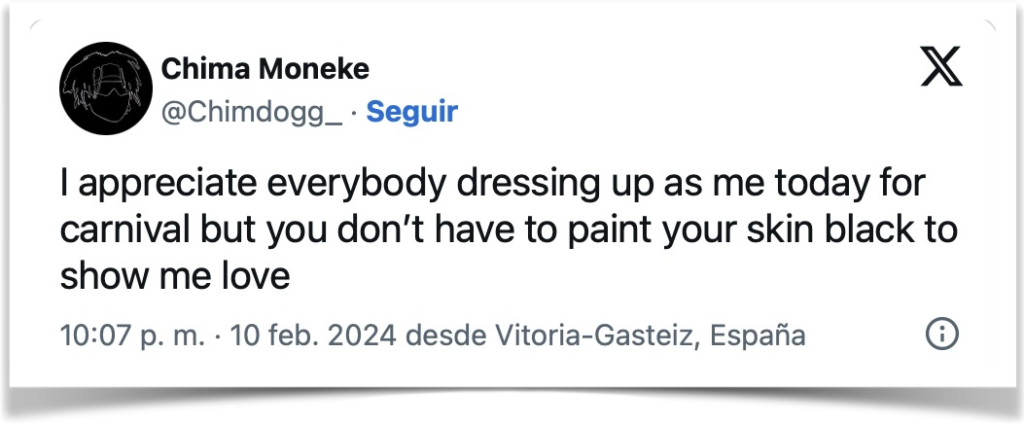15/02/24
Coach John talks about the outdated practice of ‘blackface’ which was on show in Carnival.
Click HERE to download the Weekly English Practice as a PDF.
Useful Vocabulary
- dress up: (v) to put fancy dress, disguise, etc, on (oneself or another), as in children’s games
- don: (v) to put on or dress in
- mock: (v) to make fun of; to treat with ridicule or contempt:
- black up: (v) use make-up in order to imitate the appearance of a black person. The use of such make-up was associated with minstrel shows in the United States from the 1830s until the mid 20th century; it is now regarded as highly offensive
- minstrel: (n) one of a troupe of comedians, usually white men made up as black performers, presenting songs, jokes, etc
- hurtful: (adj) causing hurt, distress, or injury
- to root: (v) to become fixed or established
- overtone: (n) an additional, usually subsidiary and implicit meaning or quality
CHIMA MONEKE CALLS OUT CARNIVAL ‘BLACKFACE’
Chima Moneke (born 24 December 1995) is a Nigerian professional basketball player for Saski Baskonia of the ACB league and the EuroLeague.
At 1.97 m. tall, he plays in the power forward position. He also represents the Nigerian national team in international competition.

Gasteiz Hoy reported that people dressing up as Chima was the most popular costume during Carnival this year. Chima himself thanked Baskonia fans but politely pointed out that donning ‘Blackface’ was not the way to show him love.
In January, Madrid’s city hall apologised after distributing videos featuring a white actor wearing blackface as part of Epiphany festivities.
One of the videos also had the man in blackface speaking in a heavy accent – leading to accusations of racism.
Blackface was an historical practice in which black people were mocked for the entertainment of white people.
It dates back around 200 years. It is seen as racist and many people find it deeply offensive.
It commonly refers to when someone – typically with white skin – paints their face darker to resemble a black person.
Several politicians and media figures, as well as Canadian Prime Minister Justin Trudeau, have been embroiled in blackface scandals in the past few years.
Gasteiz Hoy said: “in Spain it (Blackface) is something that is not yet internalised, in recent years the use of black paint to characterise oneself as black has been denounced especially among Anglo-Saxon politicians.”
Unfortunately, Gasteiz Hoy do not seem to realise that white people blacking up is racist and offensive to black people and not just ‘Anglo-Saxon’ politicians. Let’s hope Chima’s dignified response starts to change hearts and minds in our city.
- Give a summary of the text to your coach and/or classmates.
- How did Gasteiz Hoy report the use of ‘blackface’ in Carnival? Were they fair and sensitive about the issue?
- What did Chima say about people blacking up in Carnival? Do you agree with him?
- In the last two paragraphs of the text what is the implied criticism of the Gasteiz Hoy article?
- Read the text on page 2. What is the history of ‘blackface’?
- Do you know any other examples of the use of ‘blackface’? How can people be educated on the issue?

